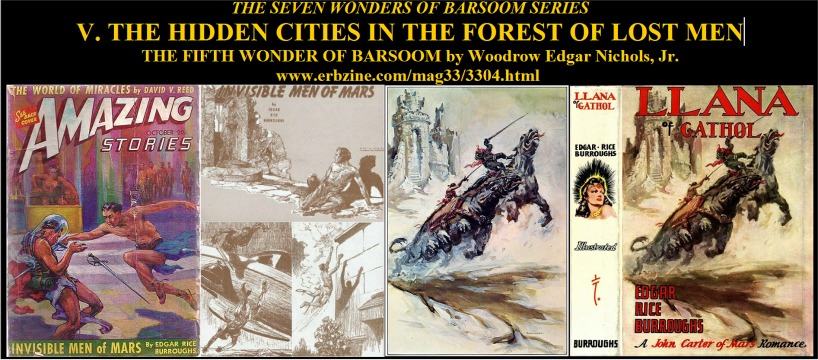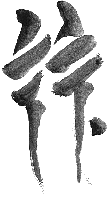THE SEVEN WONDERS OF BARSOOM SERIES
V. THE HIDDEN CITIES IN THE
FOREST OF LOST MEN:
THE FIFTH WONDER OF BARSOOM
by
Woodrow Edgar Nichols, Jr.


INTRODUCTION

We come now to the Fifth Wonder of Barsoom: the Hidden
Cities in the Forest of Lost Men. We are introduced to this fabulous
place in “The Invisible Men of Mars,” one of the four stories that make
up Llana of Gathol,
the femme fatale who is everything you would expect from a union between
of Gahan of Gathol and Tara of Helium.
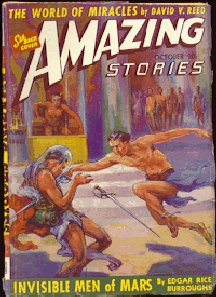 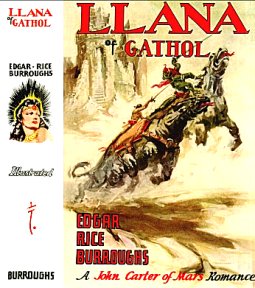 In this story, ERB explores different aspects of invisibility
that were not covered previously in A
Fighting Man of Mars (the cloak of invisibility) and Swords
of Mars (invisibility by telepathic suggestion). This time
the invisibility is pharmaceutical, caused by a pill taken once a day.
The results, in the hands of ERB, are both amusing and entertaining.
In this story, ERB explores different aspects of invisibility
that were not covered previously in A
Fighting Man of Mars (the cloak of invisibility) and Swords
of Mars (invisibility by telepathic suggestion). This time
the invisibility is pharmaceutical, caused by a pill taken once a day.
The results, in the hands of ERB, are both amusing and entertaining.
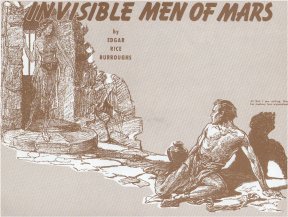

DATA

John Carter and his granddaughter, Llana of Gathol, have
just escaped from the hothouse city of Pankor in an exciting and dramatic
breakout in Carter’s personal one man flier. Days later, tired and hungry,
they spot a lush forest below:
“It was a hilly country;
and in the long, deep valley I saw one of those rarest of all sights on
Mars, a splendid forest. Now, to me, a forest means fruits and nuts and,
perhaps, game animals; and we were hungry. There would doubtless be mantilia
plants too, the sap of which would quench our thirst; and so I decided
to land. My best judgment told me that it was a risky thing to do, and
subsequent events proved that my judgment was wholly correct.” (LG/IV-1.)
Carter lands in the forest and, leaving Llana in the flier,
he goes on the hunt for food:
“The forest consisted principally
of skeel, sorapus, and sompus trees. The first two are hardwood trees,
bearing large, delicious nuts, while the sompus trees were loaded with
a citrus-like fruit with a thin red rind. The pulp of this fruit, called
somp, is not unlike grapefruit, though much sweeter. It is considered a
great delicacy among Barsoomians, and is cultivated along many of the canals.
I had never seen any, however, as large as these, growing wild; nor had
I ever seen trees on Mars of the size of many of those growing in this
hidden forest.” (LG/IV-2.)
As Carter is picking fruit and nuts, he hears Llana scream.
He drops the fruit and nuts and runs to her rescue, but as he reaches the
spot where they landed, he sees his flier, with Llana in it, rising from
the ground. He makes one of his famous jumps, leaping a good thirty feet
into the air in an attempt to grap the handrail of the flier. He just misses
it, but is able to see Llana on the deck absolutely alone with no one at
the controls before he loses his grip and falls back to the ground. He
is then captured by a patrol of invisible soldiers and as he is led to
their city, he learns a a lesson about the forest:
“‘We are coming to a bad
place,’ said the voice; ‘you had better take my arm.’
“I groped out with my right hand
and found an arm that I could not see. I grasped what felt like an upper
arm, and as I did so my hand disappeared! Now, my right arm ended
at the wrist, or at least it appeared to do so; but I could feel my fingers
clutching that arm that I could not see. It was a most eerie sensation.
I do not like situations that I cannot understand.
“Almost immediately we came to an
open place in the forest, where no trees grew. The ground was covered with
tiny hummocks, and when I stepped on it it sank down a few inches. It was
like walking on coil springs covered with turf.
“‘I’ll guide you,’ said the voice
at my side. ‘If you should get off the trail here alone you’d be swallowed
up. The worst that can happen to you would be to get one leg in it, for
I can pull you out before it gets a good hold on you.’
“‘Thank you,’ I said; ‘it is very
decent of you.’
“‘Think nothing of it,’ replied
the voice. ‘I feel sorry for you; I am always sorry for strangers whom
Fate misguides into the forest of Invak. We have another name for it, which,
I think, better describes it – The Forest of Lost Men.’
“‘Is it really so bad to fall into
the hands of your people?’ I asked.
“‘I am afraid that it is,’ replied
the voice; ‘there is no escape.’
“I had heard that one before; so
it didn’t impress me greatly. The lesser peoples of Barsoom are great braggards;
they always have the best swordsmen, the finest cities, the most outstanding
culture; and once you fall into their hands, you are always doomed to death
or a life of slavery – you can never escape them.” (LG/IV-2.)
Carter discovers that the voice belongs to Kandus and that
his captors are from the city of Invak, and in a few more minutes they
are before its gates:
“Invak! The city in the
Forest of Lost Men. At first only a gate was visible, so thickly set were
the trees that hid the city wall – the trees and the vines that covered
the wall....
“Immediately the gates swung open,
and beyond I saw a lighted corridor and people moving about within it;
then my rope tightened and I moved foward toward the gate; and ahead of
me, one by one, armed men suddenly appeared just beyond the threshold of
the gateway; one after another they appeared as though materialized from
thin air and continued on along the lighted corridor. I approached the
gate apparently alone, but as I stepped across the threshold there was
a warrior at my side where the voice of Kandus had walked.” (LG/IV-3.)
Carter asks Kandus to explain to him the mystery of their
invisibility and why they become visible once they pass the threshold into
the corridors:
“‘It is very simple, but
it is the secret of the Invaks,’ he replied. ‘I may tell you, however,
that we are invisible in daylight, or rather when we are not illuminated
by these special lamps which light our city. If you will notice the construction
of the city as we proceed, you will see that we take full advantage of
our only opportunity for visibililty.’
“‘Why should you care whether other
people can see you or not?’ I asked.
‘Is it not sufficient that you can
see them and yourselves?’
“‘Unfortunately, there is the hitch,’
he said. ‘We can see you, but we can’t see each other any more than you
can see us.” (LG/IV-3.)
This leads to some amusing situations which we will cover
below. Soon, Carter discovers another feature about Invak:
“Just then I saw an open
courtyard ahead of us, and as the warriors passed out of the lighted corridor
into it they disappeared. When Kandus and I stepped out, I was walking
alone again. It was most uncanny.
“The city was spotted with these
courtyards which gave ventilation to the city which was, otherwise, entirely
roofed and artificially lighted by the amazing lights which gave complete
visibility to the inhabitants. In every courtyard grew
spreading trees, and upon the city’s
roof vines had been trained to grow; so that, built in the center of the
Forest of Lost Men, it was almost as invisible from either the ground or
the air as were its people themselves.” (LG/IV-3.)
Carter is taken to one of these courtyards and chained to
a large tree trunk, and there experiences the strange sights and sounds
of the city:
“I could hear voices crossing
and recrossing the courtyard. I could see people come down the corridors
and then fade into nothingness as they stepped out into the courtyard.
I could see the backs of men and women quite as suddenly in the entrances
to the streets as they left the courtyard.” (LG/IV-3.)
He discovers that his old friend from Zodanga, Ptor Fak,
is chained to the tree next to him and Carter learns that his friend is
a fountain of information as they strike up a conversation:
“‘Tell me,’ I said; ‘how
do they make themselves invisible?’
“‘They have developed something
that gives them invisibility for perhaps a day; it is something they take
internally – a large pill. I understand that they take one every morning,
so as to be sure they will be invisible if they have to go outside the
city. You see it takes about an hour for the stuff to work, and if the
city were attacked by an enemy they’d be in a bad way if they had to go
out and fight while visible.’
“‘What enemies can they have around
here?’ I asked. ‘Kandus told me that even the green men are afraid of them.’
“‘There is another city in the forest
inhabited by an offshoot of this tribe,’ explained Ptor Fak; ‘it is called
Onvak, and its people also possess the secret of invisibility. Occasionally
the Onvak’s come and attack Invak, or lie in wait for the Invak hunting
parties when they go out into the forest.’
“‘I should think it might be rather
difficult to fight a battle in which one could see neither foe nor friend,’
I suggested.
“‘Yes; I understand that there’s
never very much damage done, though occasionally they capture a prisoner.
The last battle they had the Invaks took two prisoners, and when they got
them into the city they discovered that they were both their own men. They
never know how many of their own people they kill; they just go slashing
about them with their swords, and Issus help whoever gets in the way.’”
(LG/IV-4.)
Carter is later taken to the Jeddak of Invak, Ptantus, who
wants Carter to perform for him as a jumping jack, and as Carter prepares
to do so, we get an idea of how high the city roof is from the ground:
“I looked up at the ceiling.
It was only about fifteen feet from the floor. ‘That would only be a hop,’
I said.
“‘Well hop then,’ said Ptantus.
“I turned and looked behind me.
For about twenty feet between me and the doorway men and women were crowded
thickly together. Thanking my great ability and the lesser gravity of Mars,
I easily jumped completely over them. I could have made a bolt for the
door then, leaped to the roof of the city and made my escape; and I should
have done it had it not been that Llana of Gathol was still a prisoner
here.” (LG/IV-5.)
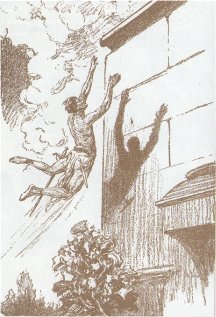
Carter is befriended by an Invakian noble woman, Rojas, who
is worried for him when she learns he is to duel Motus, the greatest swordsman
in Invak, and as an aside we learn an additional fact about the Barsoomian
game Jetan, or Martian chess:
“‘I do not wish to see
you killed,’ she said, and clung to me tightly.
“‘You haven’t a thing to worry about,
I shall not be killed; and Motus will never have Llana of Gathol or any
other woman.’
“‘You can tell his friends to start
digging his grave immediately,’ said Ptor Fak.
“‘You are that sure?’ said Rojas.
“‘We have the princess,’ said Ptor
Fak, which is the same as saying in America “It is in the bag.” The expression
derives from the Barsoomian chess game, jetan, in which the taking of a
princess decides the winner and ends the game.” (LG/IV-8.)
Carter, Ptor Fak, and Rojas conspire to escape with the help
of the invisibility pills that Rojas slips inside Carter’s pocket pouch:
“Her presence reminded
me that she had dropped something into my pocket pouch and I opened it
casually and put my hand into it. My fingers came in contact with a number
of spheres, about the size of marbles, and I knew that the secret of invisibility
was mine.” (LG/IV-8.)
The time comes for Carter to duel Motus, and much of the
action is controlled by the ticking of the great clock on the wall of the
throne room:
“I glanced at the great
clock on the wall. It was exactly the 8th zode which is the equivalent
of 10:48 P.M. Earth time.” (LG/IV-10.)
The mechanics and science of this wonderful clock are later
explained, belying all criticism that there is little science in the science
fiction of ERB:
“A Martian day is divided
into ten zodes, their being four tals to a xat, or two hundred to a zode.
The dials of their clocks are marked with four concentric circles; between
the inner circle and the next outer one the zodes are marked from one to
ten; in the next circle, the xats are marked from one to fifty between
each two zodes; and in the outer circle two hundred tals are marked between
the radii which pass through the zode numbers and extend to the outer periphery
of the dial. Their clock has three different colored and different length
hands, one indicating the zode, the second one the xat, and the longest
one the tal.
“(Editor’s note: I have before
me the diagram of the dial of a Martian clock drawn for me by John Carter
many years ago.)” (LG/IV-11.)
“‘One more tal, Motus,’ I said.
A tal is about eight tenths of an earthly second.” (LG/IV-10.)
“...and it was pretty close to what
we call midnight then, the Barsoomian midnight occurring twenty-five xats
after the eighth zode.” (LG/IV-11.)
The great clock of Invak takes on dramatic importance in
Carter’s duel with Motus, for in a moment of bravado, Carter taunts Ptantus
that he will kill him at a predetermined time:
“‘It is not time to kill
you yet, Motus,’ I said, glancing up at the clock, ‘when the hand points
to eleven xats past the 8th zode, I shall kill you.’
“‘Silence,’ screeched the referee.
“‘What is the slave saying?’ demanded
Ptantus in stentorian tones.
“‘I said,’ I shouted back at him,
‘that I should kill Motus at exactly 8 zodes, 11 xats. Watch the clock,
Ptantus, for at that instance you are going to lose your wager, and Motus
his life.’” (LG/IV-10.)
At the appointed time, Motus, who has been literally hacked
into a piece of hamburger, loses his will and runs from the room, threatening
to ruin Carter’s prophecy:
“The fight was to have
been to the death and Ptantus had wagered that I would not kill Motus.
If I did not kill him, I feared that Ptantus would then claim the money;
so I risked everything on an art I had often practiced for my own amusement.
I carried my sword hand far behind my right shoulder and then brought it
forward with all my strength, releasing the blade point first. It flew
like a sped arrow and drove through Motus’s body below the left shoulder
blade at exactly 11 xats past the 8th zode.” (LG/IV-10.)
Carter chose this time for the kill because it allowed him
the time for his invisibility pill to kick in. After killing Motus, he
is being escorted back to his tree when he makes his escape in the first
courtyard, using Invakian invisibility to his advantage. There are a few
amusing incidents as an invisible Carter rescues an invisible Llana with
the help of Ptor Fak and Rojas, who are also invisible. When Carter picks
up Llana to toss her onto the roof, we learn that the height of the roofs
of Invak are the same height as the ceiling in the Jeddak’s reception room:
“There was no overhanging
tree in this courtyard, and the roof was fifteen feet above the ground.
‘You are about to have an experience, Llana,’ I said.” (LG/IV-12.)

ANALYSIS

A. Structure and History.
The hidden cities of Invak and Onvak are located in the
Forest of Invak, also known as the Forest of Lost Men. It is a lush forest
and a rarety on Mars. The Forest of Lost Men has a double meaning: it stands
for all the people who wander into the forest and are done in by the hummocks
or the Invakians and Onvakians. It also stands for the Invakians and Onvakians
themselves, for being invisible, they are lost as to each other. The city
of Invak is in the center of the forest, so the city of Onvak must be off
to a side of the forest. The Onvakians were once part of the Invakians,
so we assume there is little difference in the structure of their cities.
The strange hummocks appear in clearings in the forest
and can swallow people whole if they wander off the right path. Some of
the trees in the forest are the tallest of their type that Carter has ever
seen, and he saw some mighty tall ones in the Valley Dor.
The city of Invak is surrounded by a wall that largely
cannot be seen because of close growing trees and vines. Practically the
only thing that can be seen in the wall is the gate at which Carter enters.
The city is comprised of streets and courtyards, the streets being roofed
corridors. The courtyards are primarily used for ventilation and are in
the open air, full of overhanging trees that largely conceal the city from
above. Special vines are grown on the rooftops, which are fifteen feet
high, making the whole city invisible to the naked eye. Thus, the city
is perfectly camouflaged.
There is no mention of towers, spires, or domes, and in
one of the chambers where we find the Jeddak Ptantus, the ceiling is fifteen
feet high. In the other chamber, the throne room, the only thing mentioned
out of the ordinary is the great clock on the wall.
The Invakians achieve both invisibility and visibility
by the means of two marvelous inventions: the invisibility pill, a sphere
about the size of a marble; and the visibility lamps, special lights that
make an invisible person visible. Each Invakian takes a pill every day,
thus maintaining a constant state of invisibility out in the open air.
Only in the lights of the city are they able to see each other, thus maintaining
the semblance of civilization.
B. The Sword Move Trick.
True fans of Barsoom would have recognized the trick
Carter used at the end of his duel with Motus as one he likely learned
from Kantos Kan in the Warhoon arena, for at the time that Carter took
notice of it, it was novel to him:
“I had little hope that
he could best his giant adversary who had mowed down all before him during
the day. The fellow towered nearly sixteen feet in height while Kantos
Kan was some inches under six feet. As they advanced to meet one another
I saw for the first time a trick of Martian swordsmanship which centered
Kantos Kan’s every hope of victory and life on one cast of the dice, for,
as he came to within about twenty feet of the huge fellow he threw his
sword arm far behind him over his shoulder and with a mighty sweep hurled
his weapon point formost at the green warrior. It flew true as an arrow
and piercing the poor devil’s heart laid him dead upon the arena.” (PM/19.)
The only other time I recall Carter learning better swordsmanship
from a Martian was in his duel with the old man in charge of the Guardian
of the North magnet in Warlord of Mars. Carter’s uncanny
ability to learn while he is fighting is how he became known as the best
swordsman on two planets.
C. The Great Clock.
Here is where ERB really has some fun and mocks all critics
who say there is little science in ERB’s science fiction. Sure, the science
in ERB’s science fiction is high school science – not Ph.D. rocket science
– but it is still obviously there. In fact, the scientific information
ERB gives about Mars in this series is extremely accurate as to the length
of days, its rotation around the sun, its size – all else is, of course,
like his Africa, a total figment of his imagination.
ERB first described Martian time in The Gods of
Mars in a footnote while announcing the time set for Carter to
be tried for heresy and treason:
“Late in the afternoon
a messenger arrived from Zat Arras to inform us that we would be tried
by an impartial body of nobles in the great hall of the temple at the 1st
zode on the following day, or about 8:40 A.M. Earth time.
“Wherever Captain Carter has used
Martian measurements of time, distance, weight, and the like I have translated
them into as nearly their equivalent in earthly values as is possible.
His notes contain many Martian tables, and a great volume of scientific
data, but since the International Astronomic Society is at present engaged
in classifying, investigating, and verifying this fund of remarkable and
valuable information, I have felt that it will add nothing to the interest
of Captain Carter’s story or to the sum total of human knowledge to maintain
a strict adherence to the original manuscript in these matters, while it
might readily confuse the reader and detract from the interest of the history.
For those who may be interested, however, I will explain that the Martian
day is a trifle over 24 hours 37 minutes duration (Earth time). This
the Martians divide into ten equal parts, commencing the day at about 6
A.M. Earth time. The zodes are divided into fifty shorter periods, each
of which in turn is composed of 200 brief periods of time, about equivalent
to the earthly second. The Barsoomian Table of Time as here given is but
a part of the full table appearing in Captain Carter’s notes.
TABLE
"200 tals................................1
xat
" 50 xats................................1
zode
" 10 zodes.............................1
revolution of Mars upon its axis." (GM/16; emphasis added.)
We find a discrepancy later on in the same story when it
comes to how many more minutes a Martian day is from an Earthly day:
“Why had I forgotten the
great difference in the length of Martian and Earthly years! The ten earth
years I had spent upon Barsoom had encompassed but five years and ninety-six
days of Martian time, whose days are forty-one minutes longer than ours,
and whose years number six hundred and eighty-seven days.” (GM/20; emphasis
added.)
Somehow, in the telling of this story, the Martian day grew
from 37 minutes longer than an Earth day to 41 minutes longer than an Earth
day. But we will not let this get in our way, for once again ERB has hidden
a puzzle inside the story of the duel with Motus.
If we imagine the Earthly day beginning at midnight, with
the 12 at the top of the dial, then the beginning of the Martian day, 6
A.M. Earthly time, would be at the top of the dial, to wit, the tenth zode.
We know a zode is approximately 2.4 hours (10 zodes = 24 hours, 37 or 41
minutes.) Thus, Carter’s trial would begin 2.4 hours after the tenth zode,
or at the beginning of the 1st zode.
For a good depiction of the Martian clock, and for some
great cartography, see the right side panel of “A Geographic Chart of
the Planet Barsoom,” by Larrie Ivey (ERBzine
#3041).
The puzzle is in figuring out in Earth time what time
is 11 zats past the 8th zode? With this in mind, we are given several equivalents
as clues:
1. 6 A.M. Earth time..................................10th
zode.
2. Midnight Earth Time..............................25
xats past the 8th zode.
3. 10:48 P.M Earth Time............................The
8th zode.
4. 8:40 A.M Earth Time..............................The
1st zode.
I came up with approximately 11:20 P.M. How about you? In
other novels ERB gives the measurements and speeds for the two moons, as
well as the distance equivalents for Mars in another table. Thus, there
is plenty of science for the readers to digest if they want to take the
time to work the puzzles out. But as ERB told his readers, he was more
interested in the story than in confusing his readers.
And there you have it, ERB’s Hidden Cities in the Forest
of Lost Men:
The Fifth Wonder of Barsoom.
|


